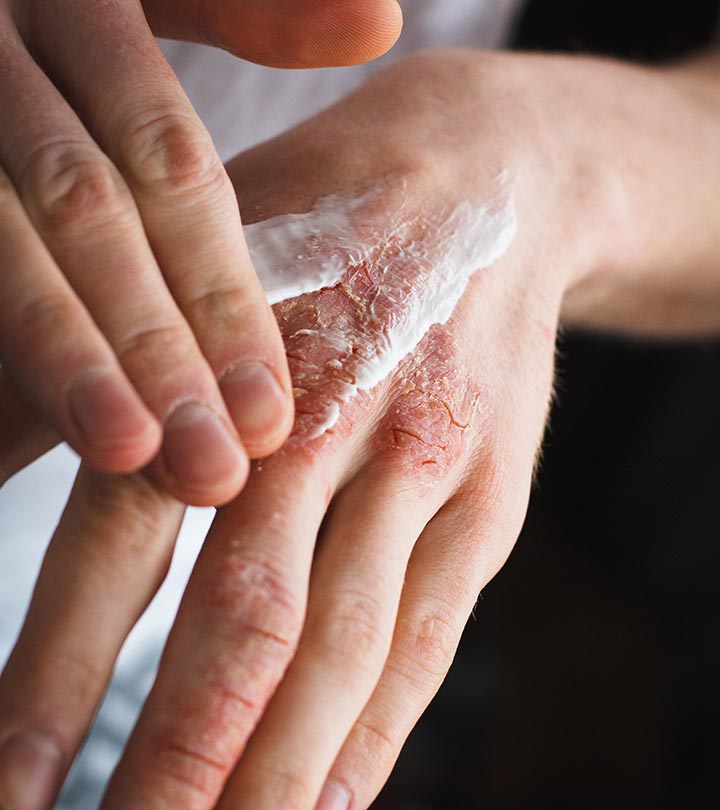Ichthyosis Vulgaris: Causes, Symptoms, Diagnosis, & Treatment
Identify the signs of this skin condition and learn about the ways to treat it.

Image: Shutterstock
Ichthyosis vulgaris, also referred to as fish scale disease, is a skin condition that affects many people. This is an ailment where the skin becomes so dry that it forms fish-like scales. Although there is no cure for this disorder at the moment, its symptoms can be treated. We have covered everything you need to know about this skin disease in this article. Keep reading!
In This Article
What Is Ichthyosis Vulgaris?
Ichthyosis vulgaris is the most common type of ichthyosis (Ick-thee-O-sis), a group of diseases that make your skin dry and scaly. In this condition, your skin looks like it has developed fish scales. There are about 20 different types of ichthyosis, and ichthyosis vulgaris is the mildest of them all.
Ichthyosis vulgaris remains confined to just one specific area of your body. However, in very rare cases, it can spread and cover large areas of your body, such as your legs, arms, chest, and abdomen. This condition often develops during childhood. Children inherit the genes causing this condition from their parents (either one or both the parents). However, it is not necessary that the parents show symptoms of this condition or have the disease to pass on its genes. This is known as inherited ichthyosis vulgaris.
It is very rare for adults to develop this condition. However, they can acquire this disease. For instance, you may develop ichthyosis vulgaris as a result of the side effects of certain medications. This is known as acquired ichthyosis vulgaris. Certain health conditions – like HIV, kidney failure, and some cancers – may also cause this condition.
According to the American Academy of Dermatology, about 95% of people who have ichthyosis develop ichthyosis vulgaris as opposed to any other form of the disease. This condition can be so mild that often people mistake it for extremely dry or dehydrated skin (1). That is the reason it usually goes undiagnosed.
Now, let’s explore the causes of this condition in detail.
What Are The Causes Of Ichthyosis Vulgaris?
As mentioned earlier in the article, you can either inherit or acquire ichthyosis vulgaris.
Causes Of Inherited Ichthyosis Vulgaris
This is caused by changes or mutation in your genes. Your genes are like codes that instruct your body to produce specific proteins and decide how your body is going to function. You can inherit this condition when there is any mutation in the gene that is responsible for encoding a protein called filaggrin.
This protein helps in developing the natural barrier of your skin. In the absence of this natural barrier, your skin cannot lock in moisture and maintain a steady pH balance. With chronic dehydration, your skin cells start to thicken and turn hard. That is when its surface becomes scaly.
A majority of the ichthyosis vulgaris cases are inherited. Those who have just a single copy of the aforementioned gene experience mild symptoms while those who get two copies of the gene (from both the parents) experience severe symptoms. However, some people have the gene mutation but still don’t experience any symptoms. These people are “carriers” who later pass on the gene to their children.
Causes Of Acquired Ichthyosis Vulgaris
Usually, adults acquire this condition. The exact cause of this type of ichthyosis vulgaris is still unknown to doctors.
People often acquire this condition from another health condition they might have. These include:
- Kidney issues
- Liver failure
- HIV infection
- Underactive thyroid gland
- Cancer (especially Hodgkin’s lymphoma)
- Sarcoidosis (a condition that causes patches of inflammation inside your body)
Ichthyosis vulgaris may also develop as a side effect of certain medications you might be taking. These includes
- Nicotinic acid (used for managing high cholesterol levels)
- Cancer medications such as vemurafenib, hydroxyurea, and protease inhibitors
- Medicines containing kava
Apart from that, ichthyosis vulgaris may also co-occur with other skin conditions that you might have, such as:
- Atopic dermatitis (also known as eczema)
- Keratosis pilaris
It is not that difficult to identify ichthyosis vulgaris by its symptoms. Here’s what you need to look out for.
What Are The Symptoms Of Ichthyosis Vulgaris?
Ichthyosis vulgaris makes your skin extremely dry, flaky, and scaly. It is characterized by the excessive build-up of keratin on the uppermost layer of your skin, which leads to the slowing down of your body’s natural shedding process. Symptoms of ichthyosis vulgaris include:
- Extremely dry and flaky skin
- Itchiness
- Tile-like scales on your skin
- Gray, brown, or white scales
- Thick and hard skin
- Deep and painful cracks on your skin
The most common parts of the body where the symptoms appear are:
- Scalp
- Torso
- Face (especially cheeks and forehead)
- Elbows and shins
If it is inherited, you will not see any symptoms until the infant is at least two months old. Scaling of the skin can cause extreme discomfort. The severity of the condition increases with age and intensifies during puberty (if it is inherited). If you think you have this condition, it is better to consult a dermatologist for further diagnosis and to manage the symptoms. Here’s what you need to know about the diagnosis and treatment of this condition.
 Pro Tip
Pro TipIchthyosis Vulgaris: Diagnosis And Treatment
A dermatologist can diagnose the condition just by taking a look at your skin condition. However, they may also:
- Inquire about your family history of skin issues
- Ask at what age you first experienced the symptoms
- Ask whether you have any other skin condition(s)
- Take note of the areas where the patches of dry skin have appeared
- Perform blood tests and skin biopsy
These steps will help the doctor chalk out an effective treatment plan to manage the symptoms and rule out the possibility of any other skin conditions with similar symptoms (such as psoriasis).
Unfortunately, this condition cannot be fully treated. However, the doctor will prescribe medicines and ointments to manage the symptoms and get rid of the dead skin cells and inflammation.
They may prescribe ointments and creams that contain:
- Lanolin
- Urea
- Propylene glycol
- Alpha hydroxy acids
- Retinoids
Taking measures to retain the moisture levels of your skin also helps in managing the symptoms. You can try the following methods to reduce scaling, dryness, and inflammation:
- Soak the affected area in bath salts or regular salt mixed with water.
- Soak the affected area in lukewarm water for a few minutes and then gently rub it with a pumice stone to exfoliate.
- After taking a shower, apply a generous amount of a moisturizer containing salicylic acid, urea, or AHAs on the affected area.
- If you have scaling on the scalp, gently brush your scalp to remove the flaky skin.
- If the symptoms are severe, use oral medications. Oral vitamin A pills can help reduce the scaling.
- Always use body lotions and skin products that have a high-fat content.
Also, you must also keep the following things in mind to reduce the chances of aggravating the condition:
- Avoid cold and dry environments and air (be extra careful during winters).
- Take short showers.
- Apply moisturizer immediately after a shower.
- Avoid air-conditioned rooms.
- Use a humidifier at home.
- Avoid exposing your skin to cold winds.
- Use sunscreen whenever you go out.
- Avoid artificial tanning.
- Stay away from swimming pools as the water may contain chemicals and chlorine that might irritate your skin.
 Pro Tip
Pro TipManaging the symptoms of ichthyosis vulgaris can be challenging, considering the restrictions and lifestyle changes that you may have to follow. The most important thing you need to be mindful of is your personal care. Talk to your doctor, follow these tips, and make them a part of your daily routine. That’s the only way to lead a healthy and normal life with this condition.
Ichthyosis vulgaris often runs in the family and cannot be cured. Even managing the symptoms can be challenging, considering the restrictions and lifestyle changes that a person must follow. The condition makes the skin extremely dry, flaky, and itchy. Managing the symptoms involves measures to retain the skin’s moisture levels, and you must be mindful of the personal care measures. It is best to consult a doctor and work with them to manage the condition. They may suggest topical creams, ointments, and oral medications to manage the condition. Follow the prescribed treatment as that is the only way to lead a healthy lifestyle with this condition.
Frequently Asked Questions
Is ichthyosis vulgaris contagious?
No, ichthyosis vulgaris is not contagious.
Is ichthyosis an autoimmune disease?
No, ichthyosis is not an autoimmune disease. It is considered an inherited skin condition.
Is Vaseline good for ichthyosis?
Yes, you can apply petroleum jelly to relieve burning and manage skin cracks.
References
- “Ichthyosis Vulgaris…” American Academy of Dermatology.
Key Takeaways
- Ichthyosis vulgaris is a skin condition that causes extremely dry and flaky skin.
- Inherited ichthyosis vulgaris is caused by your genetics, while acquired ichthyosis vulgaris may be triggered by certain diseases or as a side effect of some medications.
- You may be prescribed skin lotions or ointments containing lanolin, AHAs, or retinoids to treat this skin condition.
Equip yourself with valuable knowledge and information on dealing with Ichthyosis Vulgaris. The following video covers its causes, signs, diagnosis, and treatment options to help you manage this skin condition effectively. Click to know more.
























